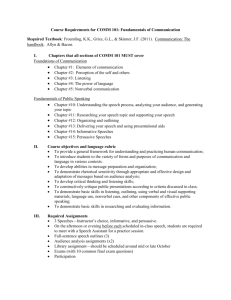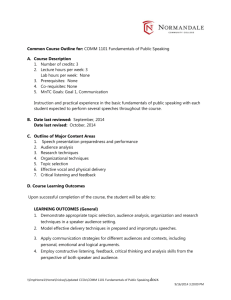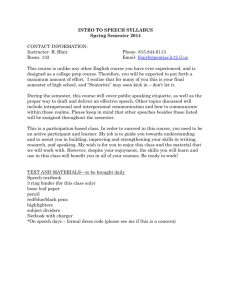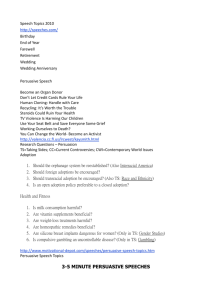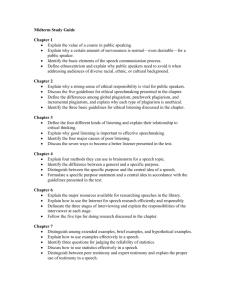Portfolio for SPCH 1311 Introduction to Speech
advertisement
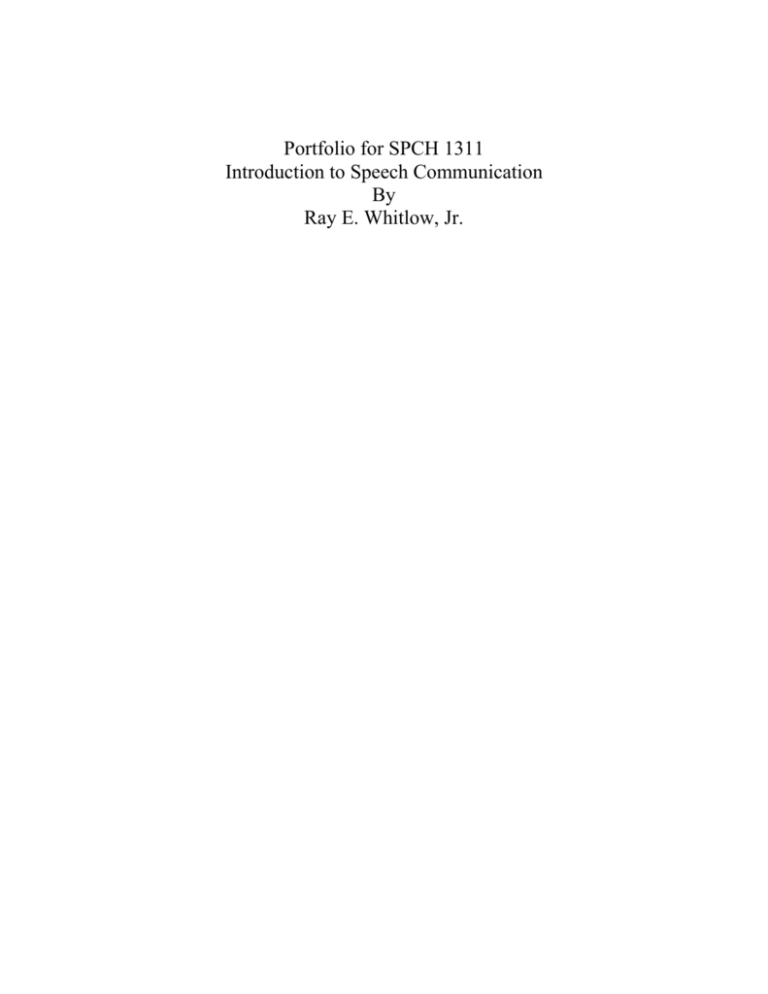
Portfolio for SPCH 1311 Introduction to Speech Communication By Ray E. Whitlow, Jr. Table of Contents Reflective Statement Course Syllabus Description of Active Learning Activity for Persuasive Speech Directions for Persuasive Speech Description of Active Learning Activity for Group Project Directions for Group Project Description of Active Learning Activity for Listening Paper Directions for Listening Paper Reflective Statement As a result of the Faculty Learning Community, I have instituted the Socratic Method in my classes as opposed to straight lecturing. In addition, I have been aided by the FLC as it has taught me to identify the language of critical thinking, thus allowing me to apply the concepts in a more specific matter to my teaching style. As a result, students can apply the principles of critical thinking not only to the class, but also in their lives. Allow me to explain. When I first started teaching public speaking, I thought that I had to lecture in order to give students directions as to how to deliver speeches. Since my class calls for students to speak, I believed if I lectured for the first day or two, they still would be participating by virtue of giving speeches. However, after being exposed to the FLC, I find students gain a far better understanding of the class if I use the Socratic Method. For instance, I used to show examples of speeches and tell why a particular presentation was good or bad. However, now I show a speech and ask questions such as: What did the speaker do that you liked? How could the speaker improve his or her delivery? Overall, what makes this a good or bad speech? These questions compel students to critically analyze speeches and draw well-reasoned conclusions not only in the classroom, but also to communication artifacts in the world in which they live. When this is done, students are more able to internalize what must be done to be effective communicators in all aspects of their lives. The FLC has also helped me integrate the language of critical thinking into my classes. For example, for the persuasive speech, the directions were as follows: Persuade the audience to believe as you do on a controversial topic. Now that I have been exposed to the FLC, I have changed the wording to: Support a well-reasoned conclusion, testing it against relevant research, on an issue that is arguable. The wording of the latter is more in line with the concepts of critical thinking. In fact, I have changed all my syllabi to reflect the design of critical thinking. In addition, I have adjusted my language in conducting class discussions so that students not only understand what critical thinking is, but use the concepts to become improved critical communicators in their lives. In summation, since the FLC, I have become a more effective instructor by asking questions as opposed to lecturing and integrating the language of critical thinking in my classes. The end result is that students understand and apply the principles of critical thinking in their lives. SYLLABUS SPCH 1311: Introduction to Speech Communication INSTRUCTOR: CONTACT: OFFICE HOURS: to 1:00 p.m. DIVISION CHAIR: ASSISTANT: (bbarclay@lee.edu) Ray E. Whitlow, Jr. (rwhitlow@lee.edu) Office: Old Gym #107 Phone: 281 425-6876 Tue. and Thur. 11:00a.m. to 12:00p.m./Mon.and Wed. 11:00a.m. Ray E. Whitlow, Jr. Beth Barclay: Phone 832 556-4003, Old Gym #104 OBJECTIVE: Critical thinking is reasonable, reflective thinking that is focused on deciding what to believe or do. As a result, one communicates effectively with others in figuring out solutions to complex problems. At the end of this course, the student should become a more critical communicator by better understanding key principles such as public speaking, interpersonal communication, and group communication, with the end result being that one arrives at more productive solutions. TEXT BOOKS: Communication: Making Connections. Seventh Edition Assignment #1 20% 6 to 8 min. Speech: To gain a more precise understanding on what must be done to achieve a profession, inform the audience on your career plans. (Five sources) Assignment #2 20% 6 to 8 min. Speech: Support a well-reasoned conclusion, testing it against relevant research, on an issue that is arguable. Ex: I support lowering the legal drinking age to 18. (Seven sources) PowerPoint Assignment #3 20% 20 min. Group Project: In order to better understand diversity in the world, in a small group, gather and assess relevant information on cultural and or gender roles and present the findings to the class. PowerPoint (Ten percent of the grade will be based on peer evaluations.) (Ten sources) Assignment #4 20% Three to five page paper: Humans don’t naturally appreciate the point of view of others or the limitations in their own perspective. Therefore, critically analyze yourself using the Johari Window so that you can better draw well-reasoned conclusions about your life in order to become a more effective communicator. (p. 368) Assignment #5 10% Three to five page paper: As stated, critical thinking involves insightful thinking. Therefore, in order to think reflectively, one must listen effectively so that one can process information and draw well-reasoned deductions. To help improve listening, analyze barriers that must be overcome in your life in order to help you arrive at more well informed conclusions. (Ch. 6) Assignment #6 10% Final Note: Homework and class participation will factor into each student's grade. The instructor must clear all speech topics. A typed outline will be turned in with each speech with the appropriate number of sources listed. The Modern Language Association (MLA) style will be used to document sources. The following grading scale will be used for all assignments: A B C D F 90 to 100 80 to 89 70 to 79 60 to 69 59 and below ABSENCES: Students who have been absent from class for three hours or three sessions may be dropped by the instructor for non-attendance with grades of “F” or “W2.” The last day to drop a class is: Statement on plagiarism: Plagiarism is presenting another person’s language or ideas as one’s own and will not be tolerated. If a student is found guilty of plagiarism, he or she will receive a failing grade on the assignment for the first offence and receive an F in the class for the second offence. Students representing Lee College and or participating in a Lee College sponsored activity are to provide their instructor with a written explanation and dates for the absences--signed by the appropriate sponsor. Sponsored activities include trips or events officially funded by the college. Any assignments missed due to explained absences must be made-up. If a student has an unexplained absence on the day he or she is due to speak, the resulting grade could be a 0. If the absence is due to extreme circumstances, this must be communicated to the instructor immediately. Arrangements must be made to make-up any missed assignments with the instructor. STATEMENT ON REASONABLE ACCOMMODATION: Lee College adheres to all applicable federal, state, local laws, regulations, and guidelines with respect to providing reasonable accommodations for students with disabilities. Students with disabilities should register with the Disabled Students Service Center and contact their instructor(s) in a timely manner to arrange for appropriate accommodations. Tentative schedule Class 1: Administrative duties; Sign up for speeches Class 16: Speeches Class 2: Library Class 17: Speeches Class 3: Discuss chapters Class 18: Speeches Class 4: Discuss chapters Class 19: Speeches Class 5: Discuss chapters Class 20: Speeches Class 6: Speeches Class 21: Prepare for Group Project Class 7: Speeches Class 22: Prepare for Group Project Class 8: Speeches Class 23: Prepare for Group Project Class 9: Speeches Class 24: Prepare for Group Project Class 10: Speeches Class 25: Prepare for Group Project Class 11: Prepare for Group Project Class 26: Prepare for Group Project Class 12: Prepare for Group Project Class 27: Group Project Class 13: Prepare for Group Project Class 28: Group Project Class 14: Review all Assignments Class 29: Group Project Class 15: Review all Assignments Class 30: Open Persuasive Speech Description of Active Learning Activity for Persuasive Speech For the persuasive speech, each student should support a well-reasoned conclusion, testing it against relevant research, on an issue that is arguable. In order for this speech to meet the requirements of the assignment, the issue must have at least two rational sides. Meaning, there must be people of sound body and mind that are for and against each stance. For example, a student could present a speech that supports lowering the legal drinking age to 18. The intent of this exercise is not to prove that one side is right or the other side is wrong. In fact, trying to prove rightness or wrongness is difficult to do on social issues because there are many different acceptable social backgrounds in the world. Instead, the intent is to get students, through critical thinking, to explore all sides of an argument, and then based on sound research, determine which side they think is the most plausible. Directions to Persuasive Speech In this presentation, students need to give sufficient information on the topic so that the audience can gain a basic understanding on the issue being discussed. Next, students must present the opposing side or sides of the topic. This is done so that the audience can have context on the issue. Meaning, how can one determine what side to support if one does not have arguments on all sides? In presenting the opposition, students can let it be known that they disagree with the opposing viewpoint. However, in the interest of fairness as well and giving the audience all details to make an informed conclusion, the opposing view or views must be presented sufficiently. Finally, students should present their arguments as to why the audience should support their findings. This speech must be documented with at least seven sources and be accompanied by a PowerPoint presentation. Group Project Description of Active Learning Activity for Group Project We live in a diverse world. In addition, gender roles are also changing each day. For example, in Asian cultures, a proper greeting is a bow whereas in the United States people shake hands. In terms of gender roles, American women can hold just about any profession, which was not the case fifty years ago. In order to better understand diversity and gender roles, in a small group, students will gather and assess relevant information and present the findings to the class. Humans tend to be egocentric. Meaning, we do not naturally consider the rights and needs of others. The intent of this exercise is to do research on aspects of different culture or gender roles so as not to continue egocentric thinking, but instead become more effective critical thinkers. Directions for Group Project The class will divided into groups based on last names. Each group is to gather and assess relevant information on cultural and or gender roles and present the findings to the class. This presentation must be at least 20 minutes in length and have at least ten sources documented in the MLA format. A PowerPoint slide show must also accompany the presentation. The entire group can choose to present, or certain members may be designated as speakers. It should be noted that all the members will get the same grade for the presentation portion, regardless of who actually has a speaking role. Ten percent of the grade will be based on peer evaluations. Meaning, everybody in the group will grade all other members from 0 to 100. Then, the average off all members will be determined and will count as half of the group project. Humans tend to be egocentric in their thinking, which is a concept that states that people only look at the world from their perspective, thus limiting their knowledge. The intent of this exercise is to do research on different culture or gender roles so as not to continue egocentric thinking, but instead become more effective critical thinkers. Listening Paper Description of Active Learning Activity for the Listening Paper In a communication class, a great deal of emphasis is on the speaking element. However, the most effective communicators are the ones who not only articulate what he or she wants to say, but also places a premium on listening. As stated, critical thinking involves insightful thinking. Therefore, in order to think reflectively, one must listen effectively so that one can process information and draw well-reasoned conclusions. To help improve listening, this assignment will call on students to analyze barriers that must be overcome in their lives in order to help them arrive at more well informed conclusions. The intent of this paper is for students to analyze their weaknesses as they pertain to listening. Once barriers can be identified, steps can be taken to overcome those barriers, so that one can become a more effective critical thinker. Directions for Listening Paper Each student will write a three to five page paper analyzing barriers that must be overcome in order to help one arrive at more well informed conclusions. Chapter six lists several common barriers. Each student should analyze barriers that pertain to their life, give examples of the barriers, and then describe how the barriers can be overcome. As stated, critical thinking involves insightful thinking. Therefore, in order to think reflectively, one must listen effectively so that one can process information and draw well-reasoned deductions. The intent of this paper is to identify and overcome listening barriers so that one becomes a more effective critical thinker. FLC Addendum How Assignments Relate to Critical Thinking As stated, critical thinking is reasonable, reflective thinking that is focused on deciding what to believe or do. This addendum will explain how the three practice exercises relate to critical thinking. Exercise one -Persuasive Speech: This exercise relates to critical thinking because it compels students to research all sides of an issue. Once thorough research has been done, students are in a better position to make knowledgeable decisions on important issues because they have sufficient information to do so. Exercise two – Group Project: This project relates to critical thinking because it compels students to explore the behavior of other societies or the opposite gender. Once this is done, students realize that other cultures or the opposite sex think and view the world in a different manner. With this knowledge, hopefully, one will expand their thinking beyond their world, which will help them make better decisions on issues in their lives. Exercise three – Listening Paper: This paper relates to critical thinking because it compels students to identify their barriers to listening. Once this is done, one can work on overcoming these barriers and obtain more relevant information, which in turn will help students arrive at more informed conclusions.
